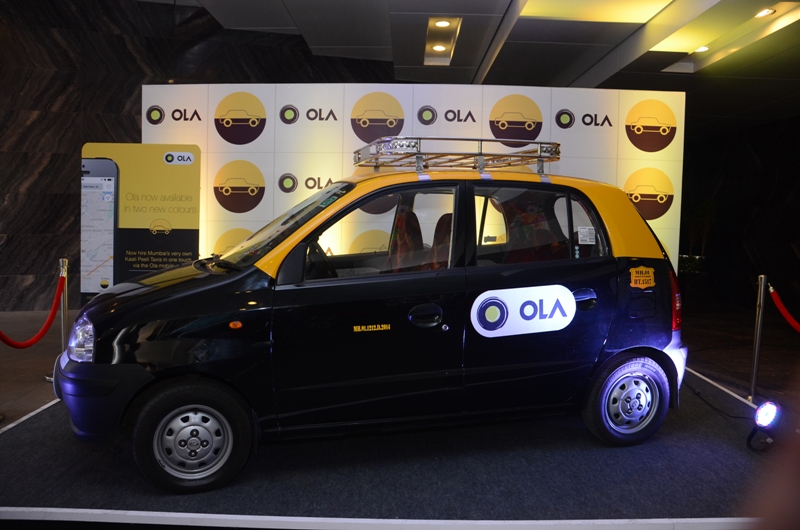
Right now, there are no offers Uber can’t refuse. Photo credit: Steve Troughton.
Ride-hailing service Ola is all set to get fresh funds worth US$250-300 million from investor SoftBank, according to local media reports.
Ola is looking to raise about US$500 million in all in the round to focus on “quality of the business, scale,” a source told The Economic Times.
Ola did not respond to an email seeking details. Now, any discussion about Ola is not without reference to its biggest rival, Uber. The companies have been at each other’s throats for years now, with things getting particularly ugly in the past few months.
See: Dear Ola (and Uber): users want efficiency, not nationalist hyperbole
Ola currently claims reach across 102 cities, allowing users to book from over 450,000 vehicles on board. As of June, Uber was aiming to get to 50 cities by the end of 2016.
Big brother

An Ola-branded taxi in India. Photo credit: Ola.
Ola has raised around US$1.2 billion till date. Uber has promised an investment of US$1 billion for India. Ola, valued at around US$5 billion (Uber’s total worth is about US$68 billion), saw revenues of about US$57 million in the year ending March 2015 (latest count available).
Ola has also lost US$119 million, a 20-fold increase over the previous year.
Uber is catching up, but Ola is still the leader by far. Industry experts particularly like its affordable car segment, called Ola Micro, which many say has helped the company further its lead.
For all of Uber’s global strength and expertise, the San Francisco-based company too has been haemorrhaging money, to the tune of $1.27 billion in the first quarter of this year (India stats not available). While Uber has to deal with operations in multiple markets and the ramifications of being a global player, Ola can focus on India and India alone. Being a local player gives it (at least on paper) an unparalleled insight into the quirks and needs of an Indian customer base, and a bevy of powerful investors – Ola counts SoftBank, Yuri Milner’s DST Global, Tiger Global, Matrix Partners, and Indian business magnate Ratan Tata among investors – can give it all the support it needs to take down its rival.

Image credit: Wikimedia.
Monday’s report suggests money is not in short supply at Ola either. Why then, is Ola not going all in to buy out Uber’s India unit, to be done with all the trouble for once and for all?
After all, there are precedents on both ends. Ola bought local rival TaxiForSure last year, a move that helped consolidate its position as market leader. Uber sold its China unit to rival Didi Chuxing earlier this year, after fighting a war worth US$2 billion there.
The short answer is, notwithstanding the muscle that comes with being the most valuable startup in the world, even Uber cannot buckle to rivals in two major markets all at once. Losing India would effectively reduce Uber to being a US-market player, with smatterings of Europe thrown in, of course.
That does not bode well for a company with global ambitions. After the Didi deal, India is as important to Uber as it is to Amazon post Bezos’ China mess-up.
Moreover, the sale of Uber China to Didi puts Ola in an uncomfortable place. Didi is an investor in Ola – the Chinese company participated in a US$500 million funding round last year.
India vs China

Photoshop by TiA. Original image from Wikimedia
India’s open market, a vast English-speaking population, and recent economic boom typically set a stage for Western companies otherwise unavailable in China. Amazon, for example, lost out massively in the land of Alibaba, but has swiftly become a close rival to Flipkart. Facebook and Whatsapp have no teeth against QQ or WeChat, but are the top players in their fields in India.
The country’s internet penetration paradox – the latest Mary Meeker Internet Trends report says India has 277 million internet users, beating the United States and trailing only to China, and yet that is only 22 percent of the country’s population – makes it a great growth market for any web-based firm.
India’s government, while not making it a joyride for either Uber or Ola, is by far less protectionist than its Chinese counterpart – putting both companies on a more or less equal footing. A Harvard Business Review article in August stated that the real reason Uber folded in China was “not because of interference from its rivals but because of interference from the state.”
All of this makes it easier for Uber to go it alone in the country, making it harder for Ola to propose a buyout, if at all. The catfights aren’t going away yet.
This is an opinion piece.
This post Why Ola can’t pull a Didi, buy Uber India, and be done with it appeared first on Tech in Asia.
from Tech in Asia https://www.techinasia.com/uber-india-ola-no-consolidation
via IFTTT
No comments:
Post a Comment